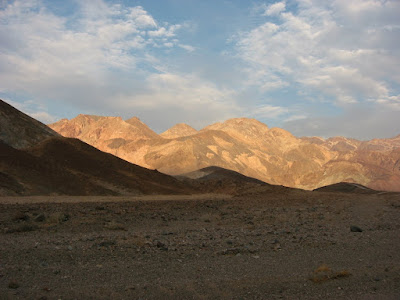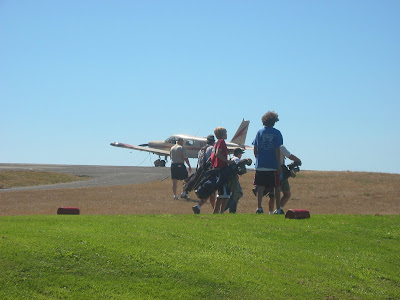I have been to Grand Canyon twice. Not surprisingly, both times I arrived and toured by automobile with family. I never got to fly myself over, bike to, or hike into the Canyon. Not only that, this time we got to overnight on the rim, hike a non-corridor trail under full moonlight, camp on a beach next to the Colorado in the Inner Gorge, and ride the full length of the Hermits Rest Road, all on the same trip!
Thursday, November 22 - Flight In
Having repositioned our plane from SMO to EMT the night before, VFR conditions did arrive sooner, but it wasn't until after 10am that the marine layer started to turn to blue skies. With favorable winds aloft at 9500'MSL, our humble 150hp Cherokee reached 130kts ground speed at times, and we arrived at GCN with only about 2 hours and 45 minutes of flight time. Conditions at landing were slightly gusty and it was our first high altitude landing.
Our flight route from El Monte to Grand Canyon Airport
After assisting us with tiedown, Tim the friendly FBO guy was a little surprised to learn that we WingTramps have not made any hotel reservations whatsoever. Knowing that it was a little late in the afternoon and that we probably weren't going to make it to the South Rim by bike that night, he recommended Seven Mile Lodge to us. It was only 1 mile away from the airport in Tusayan and was a fairly decent place to stay at a low price. That night, we DID make it to the South Rim by bike but it was a leisurely excursion under full moonlight.
Friday, November 23 - Hike In
The next morning, we found that the Phantom Ranch was full for the night (even though it had vacancy when I called in the afternoon of the previous business day) so we had to switch to Plan B, which is to backpack camp into the Canyon. We got the one and only remaining backcountry site still unassigned for that night reachable within a day's hike from the South Rim. The catch is, the Granite Rapids camp is quite a ways from the Hermit trailhead. The ranger made sure that we were the kind of people who knew what we were doing before issuing us the permit, and warned us that we'll be hiking a steep faint trail in the dark towards the end.
Our Spartan bivy camp on the Colorado
It would be 1:30pm before we reached Hermit's Rest via a 9-mile bike ride, and we locked our bikes to a Pinon pine. On the way down, we passed a normal-looking party of 2 people hiking up that we would learn later from another party of 2 further down the trail, that they somehow split up but were supposed continue hiking DOWN to join them, not back up to the Rim! We wished them luck but never found out what happened to the party afterwards. We wouldn't reach camp until after 7:30 and having got lost and cliffed out in the dark, narrow, steep canyon a couple of times. At the bottom we found an elevated river sandbar with a clear view of the Colorado under full moonlight and wasted no time with our camp duties. Compared to the breezy and crisp temperatures at the Rim that day, it was relatively warm and windless even at night at the bottom, quite inviting for late November.
Saturday, November 24 - Hike Out
We awoke to the unfettered beauty of the inner canyon. Due to the late season, the sun took forever to rise above the Rim which suited us just fine as it provided hours of low-sun-angle photographic opportunities that would otherwise be short lived during the summer season.
The cliffs of Granite Rapids under morning light
"Tunnel View" of the Colorado just downstream of Granite Rapids
Pima Point (left) and Cope Butte (right) in the background
We packed up and left at 11:30am. Because of our 35 lbs packs and the previous day's long bike/hike in all the way from Tusayan, our hike up was slowed by my muscle pain due to overuse and we didn't make it to Hermit's Rest until after 8:30 at night. By the time we got to the Village area, it was 10pm and the restaurants had just closed for the night. Fortunately we found a place to stay at the Yavapai Lodge right on the Rim. Dinner that night consisted of trail mix and other munchies, but hey, we had a heated room with TV and showers and we didn't have to bike back to Tusayan that night in the 25F cold, so we weren't complaining!
The Inner Gorge from the bottom of Cathedral Stairs
Sunday, November 25 - Flight Back
After a hearty breakfast at the Yavapai cafeteria, we biked back out to Tusayan where we bought some lunch for the return flight. Tim the FBO guy had been very friendly and helpful to us, and the parking was free, so we felt a little obligated to load up some $6.00/gal 100LL which would also free us from another refueling stop and climbout. It was a bluebird day here at GCN with forecasted VFR weather at coastal SoCal so we decided to take a tour flight around the Grand Canyon, on our own plane of course. Tim helped us in our planning and suggested that we take the Fossil Canyon Corridor because the FAA would close it forever after Jan 1 for Condor protection.
Due to GCN's density altitude of 7500', our climbout at 100 lbs under GTOW was fairly labored. Add to that a little gusty wind when we were initially climbing through the tall coniferous forest canopy, I had to add an extra 5 kts speed buffer for the climbout, which meant the climb angle didn't come remotely close to Vx at sea level! Fortunately the runway was 9000' long and our lean mixture, short field technique, and a 8 kts headwind gave us plenty of room to spare. On the climbout we experimented with different speeds and found that our climb rate was fairly insensitive to a surprising range of forward speeds from 65-80 mph indicated. The bad news is that it hovered around 250-300 fpm so it took us a while to get to our minimum 11,500' MSL altitude for the northbound corridor.
The Dragon Corridor was pretty smoke filled due to some controlled burn on the North Rim so we opted for the Zuni Point Corridor south bound. The Zuni was quite spectacular even from 10,500' MSL, a full 2,000' above the fixed-wing commercial tour flights and 3,000' above the helicopters. Even so, we were merely 2,000' above the North Rim and 1,000' above the South Rim, so at times we were barely within engine-out gliding distance to either rim. I have taken a commercial fixed-wing tour from Air Grand Canyon before in a Cessna 206 and admit that the Canyon feels more impressive lower down, but this time we were in control of the aircraft so we could fine tune our viewpoints for photography, and because there was no GA traffic in our vicinity, we were free to fly as slow as our plane allows thus giving us an option to extend our time over the Canyon, something we couldn't do on a commercial tour.
























